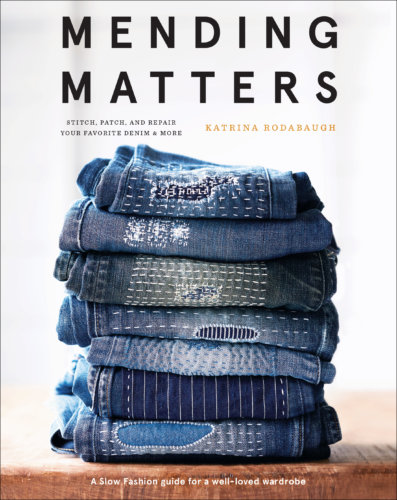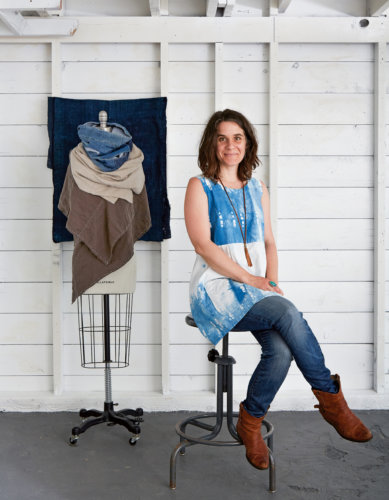
Fashion is quick to change—but rather slow to decompose, unfortunately. “Fast fashion,” the sartorial equivalent of fast food, is clothing that’s cheap to make and buy, but that comes at great expense. It’s often made of non-biodegradable synthetics, in unsafe sweatshops by poorly paid workers. Fast fashion is also putting our landfills into critical mass. (In the U.S. alone, we toss out 12.8 million tons of textiles each year.)
Katrina Rodabaugh has a beautiful solution. The author of the new book Mending Matters: Stitch, Patch, and Repair Your Favorite Denim & More, Katrina is part of the Slow Fashion movement—buying with mindfulness and repairing with mend-fulness. Katrina uses a Japanese embroidery technique called Sashiko to transform useful repairs into beautiful design elements. With some simple stitchwork, you have a chic and unique pair of jeans that would cost hundreds if you bought them new. Doing it yourself, and knowing you’re helping to save the planet, is worth a lot more.
An artist and environmentalist who has found a way to bring together both worlds, Katrina explained more about how, as she recently said, “Mending is an opportunity for creativity, acceptance, mindfulness, and celebration,” in the interview below.
 GROK NATION: People used to think of mending clothes as a way to save money, but the Slow Fashion movement seems to be reframing mending as a chic form of craftivism.
GROK NATION: People used to think of mending clothes as a way to save money, but the Slow Fashion movement seems to be reframing mending as a chic form of craftivism.
Katrina Rodabaugh: Mending was a necessary act—people mended their clothes because the clothes had value and they wanted to keep wearing them. Somewhere around the late 1990s or early 2000s, fast fashion flooded the market. It became “cheaper” to buy something new, wear it a few times, and discard it instead of buying something of higher value, keeping it in good condition, and wearing it for longer. Of course, that “cheap” price tag comes at a high cost for garment workers and the environment.
That realization came with a tragic event.
Yes. On April 24, 2013, the Rana Plaza garment factory in Dhaka, Bangladesh, collapsed, and over 1,100 people were killed. It was a structure failure that could have been avoided. This was a huge wake-up call, a tragedy so staggering that we couldn’t look away. It was the impetus for the current work of several slow fashion activists. The change had to start with ordinary people, like me, changing their ordinary lives, turning away from fast fashion. It felt like the only solution on a personal level. This is when my art project, Make Thrift Mend, was born and when Fashion Revolution was founded. I see mending as an extension of this catalyst—it’s a way to reclaim fashion, resist overconsumption, and let beautiful repair stitches be subversive, thoughtful, and also expressive.
Make Thrift Mend was a fiber art project where you didn’t buy any new clothes for an entire year. Did you find that difficult?
Well, I did buy some clothing, but it was secondhand. I stopped buying “new” clothing for an entire year while I focused on making simple garments, shopping secondhand, and mending what I already owned. At first organic undergarments, sustainable swimwear, and ethical activewear were really hard to find! But the sustainable fashion market has exploded in the last five years, so sourcing ethical clothing is much easier now. At some point I realized my project was less of a temporary fast and more of a lifestyle change. I still keep to this fashion fast in some ways today.

You use a great term in the book: mendfulness. What is that?
Mendfulness is about mindfulness and awareness in my overall wardrobe. Aligning my consumer purchases with my values and, ultimately, with my heart. It’s about the awareness of sustainable fashion as a cycle, from fiber farm to labor, to my closet, to repair, to life after my closet and beyond. How can I consider that cycle with mindfulness? How can I buy, make, or mend clothing that lasts a decade or two?
I typically see folks engaging with slow fashion in four ways: Handmade wardrobes, ethical purchases, second-hand purchases, and minimalist or capsule wardrobes. I don’t fall squarely into one of those boxes, but I can use something from each box to deepen my connection to sustainable fashion. Mending and plant-based dyes are my tools of choice, but I think the true mindfulness is about pausing before the purchase, considering need vs. want, and then pausing again before discarding clothing.

Knowing the effects of fast fashion is persuasive, but I think what’s really going to get people stitching is seeing the mended clothes in your book—they’re gorgeous!
Thank you so much! The most exciting shift for me was realizing that I could mend and repair my clothing in a way that felt like making art, that repairs could be both utilitarian and expressive. We’ve created such a disconnect between our garments and our handwork that many folks don’t realize they have permission to alter their clothes however they like. It’s a wonderful opportunity to engage with fashion without making clothes from scratch; just mend a knee, patch an elbow, and feel more connected to your clothes.
You don’t use a sewing machine. Is that because of the nature of Sashiko, and to make mending more accessible to people who may not have a sewing machine handy?
I love hand stitching. I have more control; it’s portable, and it allows for beautiful repairs. I initially started mending by hand because I was living in a tiny apartment with my very young son and mending was silent, so I could stitch while he slept. I love that the tools are so simple—thread, needle, scissors. They’re not barriers for folks who might not own sewing machines or other expensive equipment.
What guidance do you have for someone who’s interested in mending, but who may never have even sewed on a button?
There’s this great Arthur Ashe quote that’s perfect for sustainable fashion: “Start where you are, use what you have, do what you can.” When you’re first considering sustainability in fashion, it can be overwhelming to think about the entire industry. I just started with mending one pair of jeans, pausing before the next purchase, and taking it one garment at a time. Just start where you are today, use the resources you have available, and do what you can to align with your values. Then tomorrow, you get to start again.
Purchase Mending Matters on Amazon for $16.50. For more on Katrina Rodabaugh, her book, and the Slow Fashion movement, visit her website and Instagram.


Grok Nation Comment Policy
We welcome thoughtful, grokky comments—keep your negativity and spam to yourself. Please read our Comment Policy before commenting.